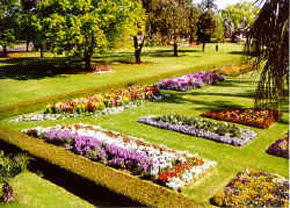|
![]()
Empire Theatre, Toowoomba
![]()
Toowoomba Flower Festival
![]()
Toowoomba Cobb & Co. Museum
![]()
Toowoomba Town Hall

Lauren Bank Park, Toowoomba
![]()
![]()
Queen Mary Falls is located in Main Range National Park in Queensland's Granite Belt
![]()
Bunya Mountains
|
Toowoomba is one of Australia's largest provincial cities, and the nation's second largest inland city after Canberra, the national capital. The major centre on the Darling Downs, Toowoomba is nationally renowned for its annual Flower Festival, held each year in September.
![]()
Where is it?: Toowoomba is located 132 km west of Brisbane, and two hours drive from the Gold Coast and Sunshine Coast beaches.
Things to see and do:
Toowoomba's history has been preserved in its buildings. Brilliant examples of fine architecture drawing from the city's wealthy beginning's include Toowoomba City Hall, the National Trust Royal Bull's Head Inn and many examples in the heritage listed Russell Street.
Toowoomba is home to the Cobb & Co Museum, hailing to the famous mail company's beginnings as a small mail run in the 1800s to transport mail and passengers to Brisbane and beyond. It also houses Australia's largest collection of horse-drawn vehicles.
Events: Toowoomba is nationally renowned for its annual Flower Festival, held each year in September. Many of the city's major parks and gardens are especially prepared for the Festival, which also includes a prominent Home Garden Competition, with persons able to visit participating homes and gardens for inspection, and a Parade with flower-themed floats. Easterfest is held annually over the Easter weekend.
Surrounding area:
The unique Bunya Mountains National Park protects the largest remaining Bunya Pine rainforests in the world. The mountains are the only outlying section of the Great Dividing Range, rising abruptly from the rich Darling Downs & South Burnett farmland. More >>
Head north from Toowoomba along the Great Dividing Range and explore an area that offers you striking scenery with an intriguing mix of natural and cultural attractions. The towns and hamlets of Highfields, Cabarlah, Hampton, Pechey, Geham, Meringandan and Crows Nest have cafes, nurseries, antique stores and museums.
The Granite Belt, to the south of Toowoomba, is focused around Stanthorpe and is bordered by the picturesque Girraween & Sundown National Parks. The Granite Belt is situated on the inner or eastern spine of the Great Dividing Range at an altitude of more than 800 metres. It is home to Queensland’s premier wine region (Granite Belt Wine Country).
About Toowoomba
The city sits on the crest of the Great Dividing Range, around 700 metres above sea level. A few streets are on the eastern side of the edge of the range, but the majority of the city is west of the divide. Toowoomba occupies the edge of the range and the low ridges behind it. Two valleys run north from the southern boundary, each arising from springs either side of Middle Ridge near Spring Street at an altitude of around 680 m. These waterways, East Creek and West Creek flow together just north of the CBD to form Gowrie Creek.
Transport: There are suburban bus services throughout the city. A limited service runs Saturday, however there are no Sunday services. There are bus services to Brisbane and other centres via commercial intercity coach services. Toowoomba is not included in TransLink the Southeast Queensland integrated public transport system. Toowoomba has a twice a week rail service from Brisbane to Charleville, Queensland and return on QR's Westlander.
Climate: Toowoomba enjoys four distinct seasons and the rich volcanic soil in the region helps maintain the 150 public parks that are scattered across the city. Jacaranda and Camphor laurel trees line many of the city streets. The city's reputation as 'The Garden City' is highlighted during the Australian Carnival of Flowers festival held in September each year. Deciduous trees from around the world line many of the parks, giving a display of Autumn colour rarely see in Australia, a continent that is almost entirely forested with evergreens.
Daily maximum temperatures in Toowoomba average 27°Celsius in summer and 16°C in winter. Late summer can see maximum temperatures as high as 39° C. While winter temperatures seldom go below freezing, snow has been reported on the higher parts of the city on rare occasions, but never settles. Light frost will be experienced several nights each winter in the city centre, and more often in the western suburbs.
History: Toowoomba's colonial history traces back to 1816 when English botanist and explorer Allan Cunningham arrived in Australia from Brazil and in June 1827 discovered 16,000 km2 of rich farming and grazing land bordered on the east by the Great Dividing Range and situated 100 miles (160 km) west of the settlement of Moreton Bay. 13 years later when George and Patrick Leslie established Toolburra Station 56 miles south-west of Toowoomba the first settlers arrived on the Downs and established a township of bark-slab shops called The Springs which was soon renamed Drayton.
Towards the end of the 1840s Drayton had grown to the point where it had its own newspaper, general store, trading post and the Royal Bull's Head Inn which was built by William Horton and still stands today. Horton is regarded as the real founder of Toowoomba, although he was not the first man to live there. Drovers and wagon masters spread the news of the new settlement at Toowoomba. By 1858 Toowoomba was growing fast. The first town council election took place on 4 January 1861 and William Henry Groom won. In 1892 the Under Secretary of Public Land proclaimed Toowoomba and the surrounding areas as a township and in 1904 Toowoomba was declared a city.
View Larger Map
|